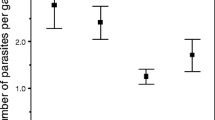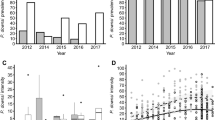Abstract
Host-parasite interactions are often influenced by environmental factors through multiple mechanisms. For example, changes in host food resources may affect multiple host traits (e.g., body size, behavior, immunocompetence), which may increase or decrease infection levels and the impact of parasites on host fitness. We often lack an understanding of which traits are most important for parasite transmission and fitness effects, posing challenges to predicting consequences of changing environmental conditions (e.g., eutrophication). Here, I examined the effects of food resources and host traits experimentally in a larval frog (Rana clamitans Latreille, 1801)—trematode parasite (Echinostoma revolutum Looss, 1899) system. I hypothesized that higher food resources reduce parasite infection and parasite effects on host growth and survival, due to increased host investment in parasite defenses, which I tested in a laboratory experiment. Contrary to my hypothesis, the results indicated that increased food levels enhanced infection in hosts, while the effect of parasites on survival did not depend on host food resources. A potential explanation for the positive effect of food level on infection was size-dependent infection rates (i.e., higher food levels increased infection through increased host growth), which is supported by a positive relationship between host body size and infection. These findings emphasize the complex relationship between host food resources and parasitism and the importance of environmental context and host traits (i.e., body size) in mediating interactions with parasites. The results also have relevance for conservation in light of rising anthropogenic impacts on aquatic systems and recent amphibian declines.


Similar content being viewed by others
References
Bedhomme S, Agnew P, Sidobre C, Michalakis Y (2004) Virulence reaction norms across a food gradient. Proc R Soc B-Biol Sci 271:739–744
Belden LK, Wojdak JM (2011) The combined influence of trematode parasites and predatory salamanders on wood frog (Rana sylvatica) tadpoles. Oecologia 166:1077–1086. doi:10.1007/s00442-011-1946-8
Bennett EM, Carpenter SR, Caraco NF (2001) Human impact on erodable phosphorus and eutrophication: a global perspective. Bioscience 51:227–234
Civitello DJ, Penczykowski RM, Smith AN, Shocket MS, Duffy MA, Hall SR (2015) Resources, key traits and the size of fungal epidemics in Daphnia populations. J Anim Ecol 84:1010–1017. doi:10.1111/1365-2656.12363
Daly EW, Johnson PTJ (2011) Beyond immunity: quantifying the effects of host anti-parasite behavior on parasite transmission. Oecologia 165:1043–1050
Daskin JH, Alford RA (2012) Context-dependent symbioses and their potential roles in wildlife diseases. Proc R Soc B-Biol Sci 279:1457–1465. doi:10.1098/rspb.2011.2276
Detwiler JT, Bos DH, Minchella DJ (2010) Revealing the secret lives of cryptic species: examining the phylogenetic relationships of echinostome parasites in North America. Mol Phylogenet Evol 55:611–620. doi:10.1016/j.ympev.2010.01.004
Fernandes FR, Cruz LD, Linhares AX, Von Zuben CJ (2015) Effect of body size on the abundance of ectoparasitic mites on the wild rodent Oligoryzomys nigripes. Acta Parasitol 60:515–524. doi:10.1515/ap-2015-0073
Fried B, Pane PL, Reddy A (1997) Experimental infection of Rana pipiens tadpoles with Echinostoma trivolvis cercariae. Parasitol Res 83:666–669
Gosner KL (1960) A simplified table for staging anuran embryos and larvae with notes on identification. Herpetologica 16:183–190
Gross RL, Newberne PM (1980) Role of nutrition in immunological function. Physiol Rev 60:188–302
Hall SR, Simonis JL, Nisbet RM, Tessier AJ, Caceres CE (2009) Resource ecology of virulence in a planktonic host-parasite system: an explanation using dynamic energy budgets. Am Nat 174:149–162
Harrod C, Griffiths D (2005) Ichthyocotylurus erraticus (Digenea: Strigeidae): factors affecting infection intensity and the effects of infection on pollan (Coregonus autumnalis), a glacial relict fish. Parasitology 131:511. doi:10.1017/S0031182005007985
Hatcher MJ, Dick JTA, Dunn AM (2006) How parasites affect interactions between competitors and predators. Ecol Lett 9:1253–1271
Hechinger RF (2013) A metabolic and body-size scaling framework for parasite within-host abundance, biomass, and energy flux. Am Nat 182:234–248
Holland MP, Skelly DK, Kashgarian M, Bolden SR, Harrison LM, Cappello M (2007) Echinostome infection in green frogs (Rana clamitans) is stage and age dependent. J Zool 271:455–462. doi:10.1111/j.1469-7998.2006.00229.x
Johnson PTJ, Chase JM (2004) Parasites in the food web: linking amphibian malformations and aquatic eutrophication. Ecol Lett 7:521–526
Johnson PTJ, Chase JM, Dosch KL, Hartson RB, Gross JA, Larson DJ, Sutherland DR, Carpenter SR (2007) Aquatic eutrophication promotes pathogenic infection in amphibians. Proc Natl Acad Sci U S A 104:15781–15786
Kanev VR, Sterner M, Fried B (2000) An overview of the biology of echinostomes. In: Fried B, Graczyk TK (eds) Echinostomes as experimental models for biological research. Kluwer Academic Publishers, Boston, pp 1–29
Koprivnikar J, Forbes MR, Baker RL (2006) On the efficacy of anti-parasite behaviour: a case study of tadpole susceptibility to cercariae of Echinostoma trivolvis. Can J Zool 84:1623–1629
Koprivnikar J, Redfern JC, Mazier HL (2013) Variation in anti-parasite behaviour and infection among larval amphibian species. Oecologia. doi:10.1007/s00442-013-2857-7
Loy C, Motzel W, Haas W (2001) Photo- and geo-orientation by echinostome cercariae results in habitat selection. J Parasitol 87:505–509
Marino JA, Werner EE (2013) Synergistic effects of predators and trematode parasites on larval green frog (Rana clamitans) survival. Ecology 94:2697–2708. doi:10.1890/13-0396.1
Marino JA, Holland MP, Middlemis Maher J (2014) Predators and trematode parasites jointly affect larval anuran functional traits and corticosterone levels. Oikos 123:451–460. doi:10.1111/j.1600-0706.2013.00896.x
Marino JA, Holland MP, Werner EE (2016) Competition and host size mediate larval anuran interactions with trematode parasites. Freshwater Biol 61:621–632
Pedersen AB, Greives TJ (2008) The interaction of parasites and resources cause crashes in a wild mouse population. J Anim Ecol 77:370–377
Preston DL, Orlofske SA, Lambden JP, Johnson PTJ (2013) Biomass and productivity of trematode parasites in pond ecosystems. J Anim Ecol 82:509–517. doi:10.1111/1365-2656.12030
Pulkkinen K, Ebert D (2004) Host starvation decreases parasite load and mean host size in experimental populations. Ecology 85:823–833
Raffel TR, Hoverman JT, Halstead NT, Michel PJ, Rohr JR (2010) Parasitism in a community context: trait-mediated interactions with competition and predation. Ecology 91:1900–1907
Rasmussen TK, Randhawa HS (2015) Factors influencing spatial variation and abundance of a mermithid parasite in sand hoppers. Parasitol Res 114:895–901. doi:10.1007/s00436-014-4254-5
Reeve BC, Crespi EJ, Whipps CM, Brunner JL (2013) Natural stressors and Ranavirus susceptibility in larval wood frogs (Rana sylvatica). Ecohealth 10:190–200. doi:10.1007/s10393-013-0834-6
Relyea RA (2001) Morphological and behavioral plasticity of larval anurans in response to different predators. Ecology 82:523–540
Rohr JR, Swan A, Raffel TR, Hudson PJ (2009) Parasites, info-disruption, and the ecology of fear. Oecologia 159:447–454
Sandland GJ, Minchella DJ (2003) Effects of diet and Echinostoma revolutum infection on energy allocation patterns in juvenile Lymnaea elodes snails. Oecologia 134:479–486
Schell SC (1985) Handbook of trematodes of North America north of Mexico. University Press of Idaho, Moscow
Schmidt KA, Fried B (1996) Emergence of cercariae of Echinostoma trivolvis from Helisoma trivolvis under different conditions. J Parasitol 82:674–676
Skelly DK, Bolden SR, Holland MP, Freidensburg LK, Friedenfelds NA, Malcom TR (2006) Urbanization and disease in amphibians. In: Collinge SK, Ray C (eds) Disease ecology: community structure and pathogen dynamics. Oxford University Press, Cary, pp 153–167
Smith VH, Ii TPJ, Smith MS (2005) Host nutrition and infectious disease: an ecological view. Front Ecol Environ 3:268–274
Stuart SN, Chanson JS, Cox NA, Young BE, Rodrigues A, Fischman DL, Waller RW (2004) Status and trends of amphibian declines and extinctions worldwide. Science 306:1783–1786
Thiemann GW, Wassersug RJ (2000) Patterns and consequences of behavioural responses to predators and parasites in Rana tadpoles. Biol J Linn Soc 71:513
Tschirren B, Richner H (2006) Parasites shape the optimal investment in immunity. Proc R Soc B-Biol Sci 273:1773–1777
Venesky MD, Wilcoxen TE, Rensel MA, Rollins-Smith L, Kerby JL, Parris MJ (2012) Dietary protein restriction impairs growth, immunity, and disease resistance in southern leopard frog tadpoles. Oecologia 169:23–31. doi:10.1007/s00442-011-2171-1
Zaret T, Suffern J (1976) Vertical migration in zooplankton as a predator avoidance mechanism. Limnol Oceanogr 21:804–813
Zelmer DA, Arai HP (1998) The contributions of host age and size to the aggregated distribution of parasites in yellow perch, Perca flavescens, from Garner Lake, Alberta, Canada. J Parasitol 84:24–28
Acknowledgments
I thank Ariel Heldt, Alexandria Novo, and Nathan Katlein for research assistance and Earl Werner and my dissertation committee for helpful comments. This work was supported by the National Science Foundation (DEB 1110137) and the University of Michigan Edwin S. George Reserve Scholarship Award.
Author information
Authors and Affiliations
Corresponding author
Ethics declarations
Ethical approval
All applicable international, national, and/or institutional guidelines for the care and use of animals were followed. All procedures performed in studies involving animals were in accordance with the ethical standards of the institution at which the studies were conducted. This research was performed in accordance with the University of Michigan UCUCA Protocol #07765.
Rights and permissions
About this article
Cite this article
Marino, J.A. Host food resource supplementation increases echinostome infection in larval anurans. Parasitol Res 115, 4477–4483 (2016). https://doi.org/10.1007/s00436-016-5234-8
Received:
Accepted:
Published:
Issue Date:
DOI: https://doi.org/10.1007/s00436-016-5234-8




